BY ALAN M. PETRILLO
Chemical, biological, radiological, nuclear, and explosive (CBRNE) response units take on a number of forms, from purpose-built apparatus, to tractor- and truck-hauled trailers, separate sections on rescues and hazmat trucks, and even marine units. The level of CBRNE response for a particular fire department or protection agency depends on the scope of its coverage and the types of units and specialized personal protective equipment (PPE) that are needed to handle emergency situations.
LAND UNITS
Mike Mildner, rescue sales specialist for E-ONE, says his company recently built a CBRNE unit for a Chinese customer on a European MAN cab over chassis that needed to be narrow enough to pass Chinese inspection for a 96-inch maximum body width. “The unit is powered by a Mercedes 270-horsepower (hp) engine,” Mildner points out, “and has a CBRNE filtration system under the seats in the module. It’s a positive-pressure system, and in the event they get into a hot spot, the driver can be in a hazmat suit up front, and the guys in the module can be working back there unsuited.”
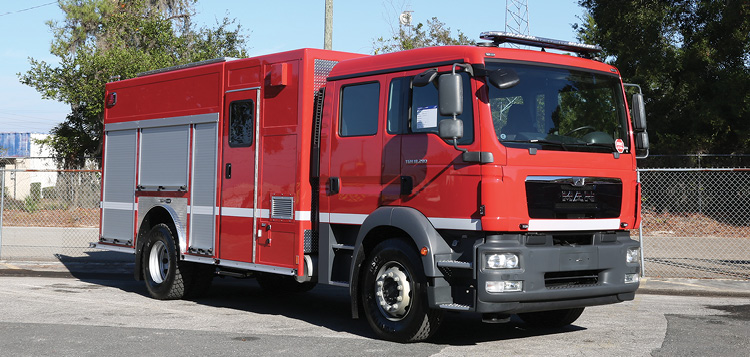
1 E-ONE built two of these CBRNE response vehicles for a Chinese customer on a MAN cab over chassis powered by a Mercedes 270-hp engine. (Photos 1-2 courtesy of E-ONE.)

2 The CBRNE units that E-ONE built for its Chinese customer have a positive-pressure CBRNE filtration system under the seats in the rear module to allow personnel to work unsuited in the module while the vehicle is in a hot spot.
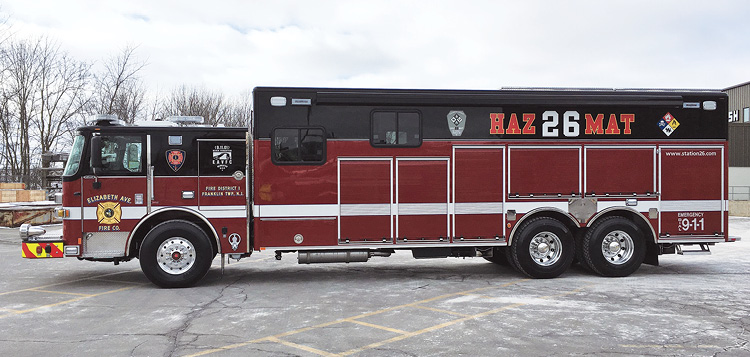
3 Pierce Manufacturing Inc. built this CBRNE hazmat response rig for the Franklin Township (NJ) Fire District #1. (Photos 3-5 courtesy of Pierce Manufacturing Inc.)
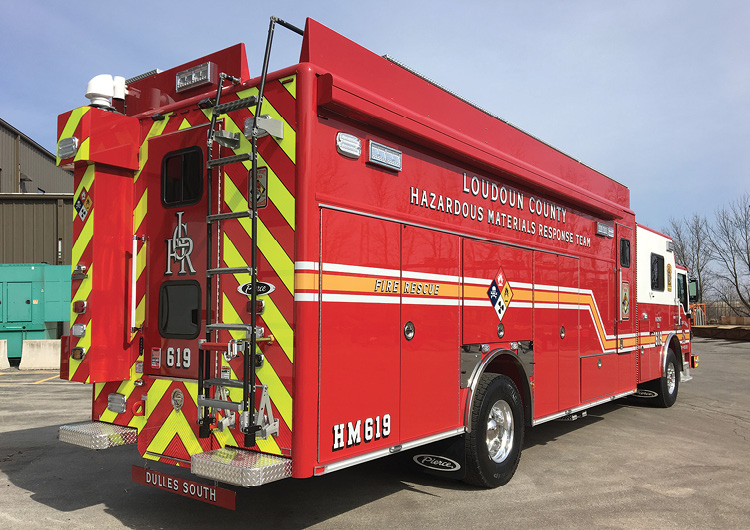
4 Loudon County (VA) had Pierce Manufacturing build this CBRNE hazmat response team vehicle.
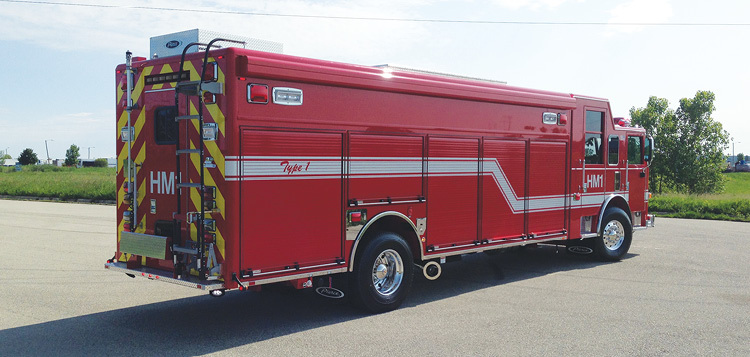
5 Pierce built this CBRNE hazmat truck for the San Diego County (CA) Fire Department.
Mildner notes that by using the special filters in the pressurized environment, the truck can drive into hot spots, and no contaminants can get into the protected space. “If they have to go outside to do some work, they can don a hazmat suit, turn off the pressurized module system, deal with the situation outside, then reboard the module and repressurize it,” he says. “The unit also carries decon equipment in its compartments and 120 gallons of water in the B1 compartment with its own tank fill, as well as a mixture of decontamination solvents.”
He continues, “The truck has a transverse compartment at L1 and R1, and there are two coffin compartments on top of the truck, along with an air-conditioning module. This is essentially a CBRNE-protected walk-around rescue with a water tank.”
Shane Braun, product manager for rescue products at Pierce Manufacturing Inc., says Pierce has made various rescue-style units to handle CBRNE situations, mostly on hazmat type vehicles but also including explosive ordinance disposal (EOD) rigs. “We’ve built these vehicles on a wide range of chassis, from Ford F-550 chassis to tandem-axle rescue bodies and also on trailers. “Hazmat teams dealing with CBRNE issues want the ability to have a resource area on the vehicle and also the ability to stay on scene for long periods of time,” Braun points out. “Often we will outfit these vehicles with an auxiliary power unit or diesel-powered generator that can power the truck with the vehicle’s main motor shut down.”
The typical layout for a CBRNE hazmat truck, whether single or tandem rear axle, has a resource center directly behind the driver and officer positions or sometimes built into the body. “They want a gathering area where they can bring multiple people into the vehicle for briefings, and they also want space for meters and monitoring equipment that must always be charged,” Braun notes. “The rear of this typical truck would be bulk storage that’s accessible from outside the vehicle.”
Braun adds that Pierce has built some vehicles with positive-pressure areas in them and also units with a small lab in the rear of the vehicle. “We’ve done some of them with a small fume hood inside the module, but the rest of the vehicle usually is dedicated to equipment storage,” he says. “We’ve also installed fresh water tanks and gray water tanks on some hazmat trucks, like those we built for the San Diego County (CA) Fire Department.”
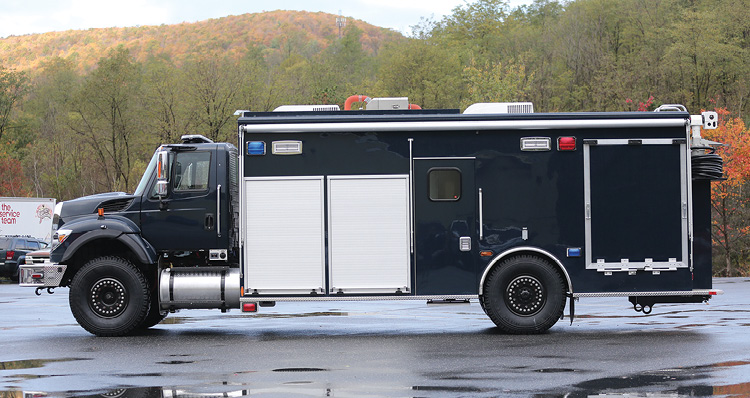
6 KME built eight EOD trucks for the U.S. Navy on International 7600 two-door walk-in rescue chassis and cabs that can be sealed against contamination. (Photos 6-9 courtesy of KME.)
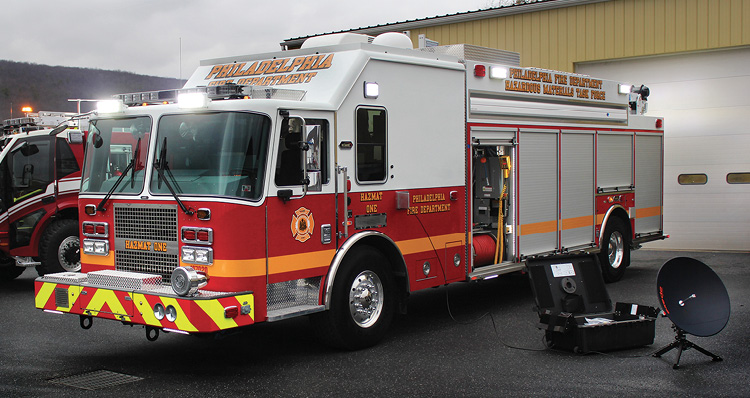
7 KME built this CBRNE hazardous materials rig for the Philadelphia (PA) Fire Department’s Hazardous Materials Task Force.
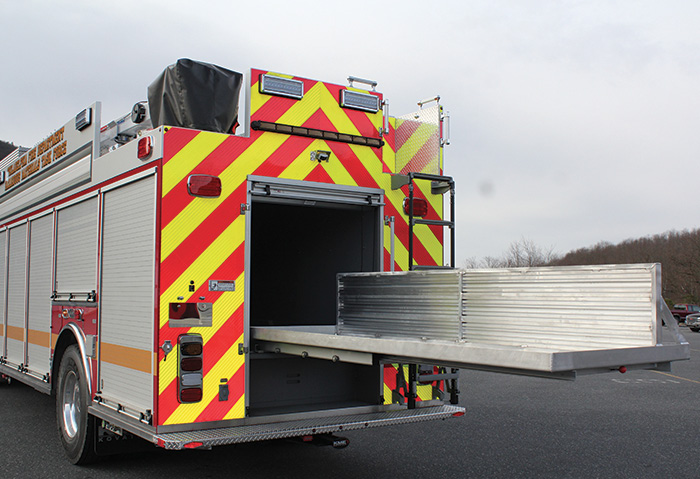
8 Philadelphia’s hazmat unit has a 12-foot slide-out in the rear compartment and trays and tool boards in all the side compartments.
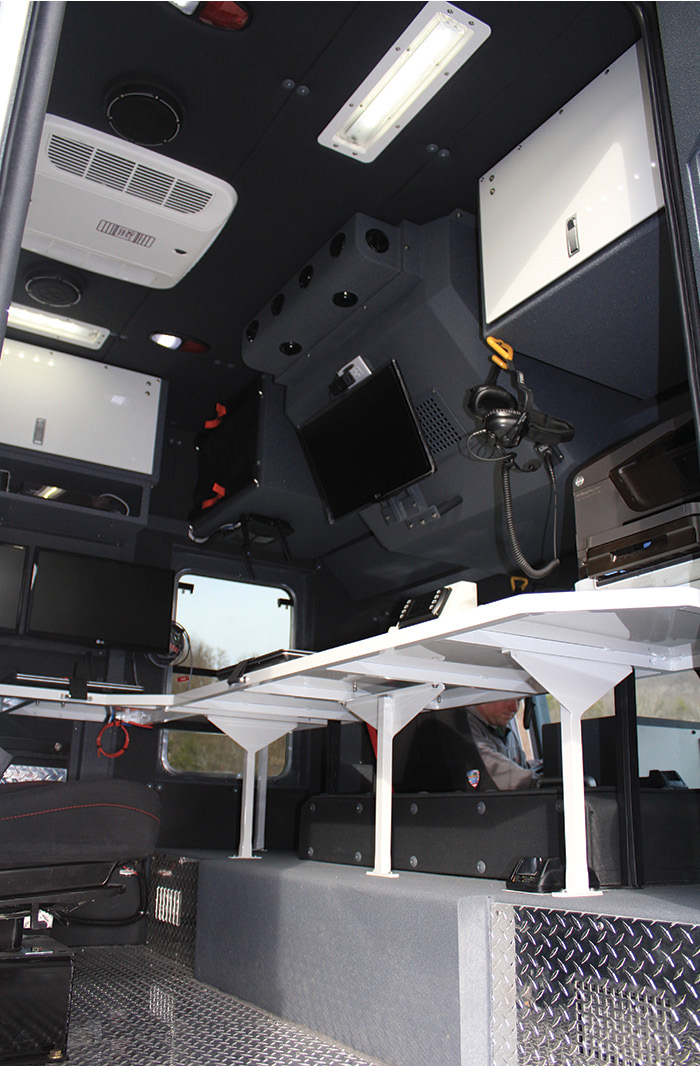
9 The interior command area on the Philadelphia CBRNE hazmat truck can monitor cameras, infrared sensors, a weather station, and satellite connection on two telescoping masts at the rear of the vehicle.
Ricardo M. Salabarria, division chief of special operations for Tampa (FL) Fire Rescue, says Tampa runs a CBRNE hazmat unit built on a Pierce chassis and rescue body. “This vehicle is used by our Hazardous Incident Team and carries all the specialized hazmat and CBRNE equipment needed to handle an incident,” Salabarria says. “It carries different types of handheld portable chemical detectors, like for nerve or blister agents, and radiation detectors. We also have a portal for use by personnel contaminated by radioactive material where they walk through and detect the amount of contamination.”
Tampa’s Pierce unit has roll-up doors all around, an air-conditioning unit in the back, and an area inside the body that can serve as a command area as well as store meters in a climate-controlled environment.
Doug Kelley, director of engineering and sales support at KME, says KME built eight EOD units on International 7600 two-door walk-in rescue chassis and cabs for the U.S. Navy that can be sealed against external contamination. “The units have a positive-pressure vent system that sucks in air through a HEPA filter, although various types of other filters can be used,” Kelley says. “There’s a diesel generator on the officer’s side to power the truck without using the chassis engine, and the units have a mast on the back with a camera, night vision, and infrared sensors. Each rig has a robot storage area at the rear of the truck and also explosives storage in a special compartment that is isolated from the interior.”
Bruce Nalesnik, chassis group product manager for KME, says KME built a CBRNE hazmat unit for the Philadelphia (PA) Fire Department on a three-door rescue body. “The truck has a command center station inside, while the back part of the body is walk-around storage,” Nalesnik says. “There’s a 12-foot slide-out in the rear compartment and trays and tool boards in all the side compartments. The Philly rig has two telescoping masts at the rear that house cameras, infrared sensors, a weather station, and a satellite connection, as well as an Auto-Crane at the left-rear of the vehicle.”
Nicholas Del Re, deputy chief of hazmat for the Fire Department of New York (FDNY), says its CBRNE hazmat units each carry both Level B hazmat ensembles and Lion’s MT94™ Multi-Threat Protection gear. Because the MT94 gear meets both National Fire Protection Association (NFPA) 1994, Standard on Protective Ensembles for Fire Responders to Hazardous Materials Emergencies and CBRN Terrorism Incidents, and NFPA 1992, Standard on Liquid Splash Protective Ensembles and Clothing for Hazardous Materials Emergencies, “it allows our personnel to operate more tactically in situations like rescue, reconnaissance, and decontamination and has dramatically enhanced our capabilities compared with using Level A suits.”
Del Re notes that Haz Mat 1 is FDNY’s specialist unit that has a full complement of hazmat equipment. “We use a tiered response of personnel who can perform missions that might require more labor-intensive operations such as rescue and recon and even decon,” he says. “Because of our tiered response system, we are able to handle multiple incidents simultaneously.”
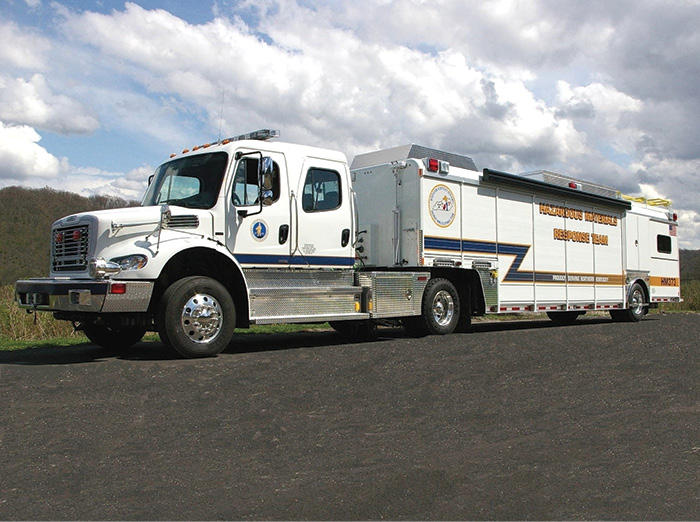
10 Summit Fire Apparatus built this CBRNE hazmat tractor and trailer for the Hamilton County (OH) Hazardous Materials Response Team. (Photo courtesy of Summit Fire Apparatus.)
FDNY operates five rescues and eight squads with hazmat technicians, coupled with a second apparatus that carries a complement of heavy rescue and hazmat equipment. Its tech engine companies have additional hazmat training and equipment and also a pumper as the second vehicle with hazmat equipment. Its decon engines have chemical protective clothing and decon equipment, while the 25 ladder companies of its Special Operations Command have an additional small vehicle carrying hazmat clothing, equipment, and decon materials.
Joe Messmer, president of Summit Fire Apparatus, says Summit has built a number of CBRNE hazmat trailers, typically 35- to 40-footers. “Usually there’s a 25-kW generator on the tractor and a heavy-duty electrical connection to the trailer, which can be disconnected and powered by the generator,” he says. Tractors most often used are Freightliner M2 112 four-door units, although Summit has furnished some International two- and four-door Model 4300 tractors.
“Almost all of the hazmat units we’ve built have a room in the back where they can examine the chemicals in a lab, which are typically passed through a small side door and put into a controlled hood with an extractor to extract the fumes and test for different chemicals,” Messmer points out. “These rooms are constructed to be weatherproof, so they can be hosed out and cleaned of any contaminants.”
MARINE UNITS
Joe Abbamonte, FDNY’s chief of the marine battalion, says FDNY operates two 140-foot fireboats, Marine 1 (Three Forty Three) and Marine 9 (Firefighter II), that are fully CBRNE-protected. “It’s a military-grade CBRNE filtration system similar to that used by the U.S. Navy,” Abbamonte observes. “The system creates positive pressure and filtered air, allowing a safe space to work inside the vessel and not be exposed to contamination. We call it the Citadel.” The two boats also have airlocks and decontamination corridors, allowing the department to put personnel in hazmat suits outside to mitigate a hazard or make a rescue.
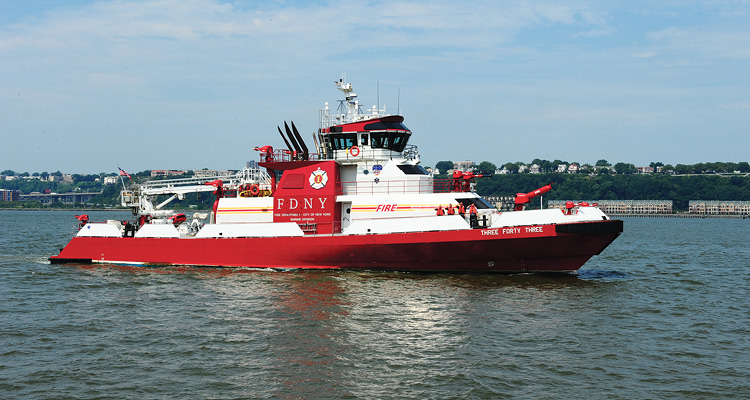
11 The FDNY’s fire boat Three Forty Three has a military-grade CBRNE filtration system that creates positive pressure and filtered air, allowing a safe space to work inside the 140-foot vessel. (Photos 11-14 courtesy of Fire Department of New York.)
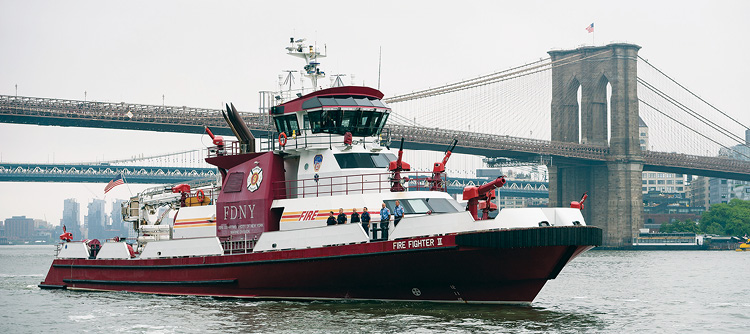
12 The FDNY’s Firefighter II, also a 140-footer, has the same CBRNE filtration system, air locks and decontamination corridors as the Three Forty Three.
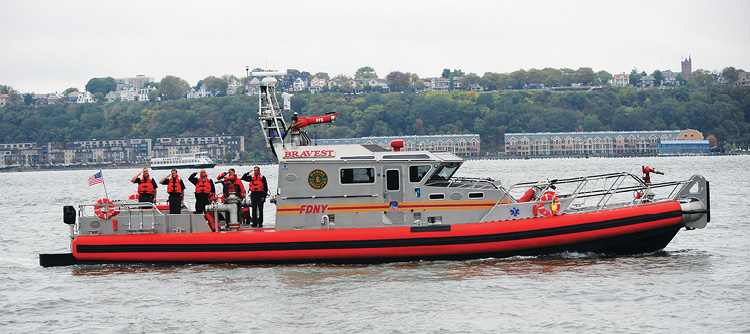
13 The FDNY’s Marine 6 (Bravest) is a 65-foot Fast Boat that has a CBRNE protection system similar to that on its larger sister vessels .

14 William J. Feehan, a 66-foot MetalCraft Marine fireboat operated by the FDNY’s marine battalion, also has a CBRNE protection system.
FDNY also operates the CBRNE-protected Marine 6 (Bravest), a 65-foot Fast Boat, and the 66-foot William J. Feehan, a MetalCraft Marine fire boat. Abbamonte notes that both the Bravest and the Feehan have smaller CBRNE protection systems than those on the two largest fireboats but no airlocks or decon corridors. “These boats can operate in a contaminated environment, like putting water on a chemical fire, where the crew is protected inside, and use outside systems like foam or water remotely,” Abbamonte says. All four of FDNY’s CBRNE-protected fireboats carry Level B hazmat suits, and Lion’s Multi-Threat Protection suits onboard.
Tampa Fire Rescue is responsible for primary fire suppression in and around the industrialized port area, the shipping channel, and all waters of Tampa Bay to Egmont Key. The Port Authority and Marine Division maintains a CBRNE-protected MetalCraft Marine 69-foot Patriot fire rescue boat, capable of pumping 12,000 gallons per minute (gpm). Tampa also has a 30-foot Sea Ark with a 1,250-gpm flow and a 27-foot Boston Whaler with a 1,250-gpm flow, but neither is CBRNE-protected.
Matthew Velluto, director of business development for Ribcraft USA, says Ribcraft has produced some CBRNE-protected boats, typically larger fire rescue boats with cabins and running in the 27-foot range and up. “We can set up an enclosed cabin for CBRNE protection with sensors that can detect a chemical in the atmosphere and provide filtered air inside to protect against contamination,” Velluto says. “On an open boat, we can give CBRNE-detection capability by hard wiring sensors into the boat and equipping the occupants with safety masks or containment hoods.”
ALAN M. PETRILLO is a Tucson, Arizona-based journalist, the author of three novels and five nonfiction books, and a member of the Fire Apparatus & Emergency Equipment Editorial Advisory Board. He served 22 years with the Verdoy (NY) Fire Department, including in the position of chief.

